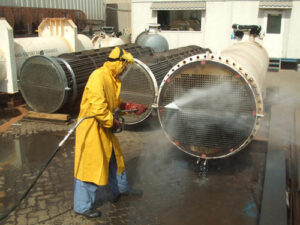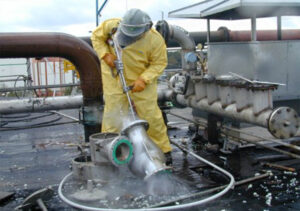Hydro Jetting
 Hydro Jetting is a non-invasive plumbing solution that clears pipes by removing blockages effectively. It involves the use of high-pressure water jets, which can remove debris, clogs, and buildup from the pipeline. It is a widely-used method or process to remove coating materials, accumulated contamination and dirt buildup on surfaces as well as blockages on pipes using high-velocity water pressure through a jet nozzle. Hydro Jetting powerfully solves the most stubborn obstructions, efficiently and effectively eliminating all debris in the sewer lines and leaves them clean as new.
Hydro Jetting is a non-invasive plumbing solution that clears pipes by removing blockages effectively. It involves the use of high-pressure water jets, which can remove debris, clogs, and buildup from the pipeline. It is a widely-used method or process to remove coating materials, accumulated contamination and dirt buildup on surfaces as well as blockages on pipes using high-velocity water pressure through a jet nozzle. Hydro Jetting powerfully solves the most stubborn obstructions, efficiently and effectively eliminating all debris in the sewer lines and leaves them clean as new.
 Hydro jetting is basically power-washing with water, set at parameters appropriate for the intended use. The water stream’s flow rate, speed, shape, direction, mass and/or the pressure are mainly determined by the type of jet nozzles and the operating pressure.
Hydro jetting is basically power-washing with water, set at parameters appropriate for the intended use. The water stream’s flow rate, speed, shape, direction, mass and/or the pressure are mainly determined by the type of jet nozzles and the operating pressure.
Different types of nozzles, in terms of design and material used, are available for various applications. Among the commonly used nozzle designs are the following:
- Flat jet nozzles have a wide, slot-shaped hole that creates a water jet in a triangular, fan-shaped spray pattern.
- Point jet nozzles have a round hole that releases a precise, focused water jet. It is a penetrating nozzle that has a much higher impact than flat jet nozzles, and is often used in cleaning pipes, tanks, filters and component parts, and removing concrete or rust.
- Rotating nozzles have a rotating portion that sprays to the sides as well as straight ahead; this is the best nozzle for cleaning pipe walls after dislodging blockages.
Each of the above types of nozzles has several variations to best fit specific requirements.
In terms of materials used, the three most common jet nozzles are carbide, steel and sapphire nozzles. According to industry experts, the useful life of a jet nozzle is greatly affected by the quality of the water to be used and the operating pressure.
- Carbide nozzles – The most durable material for dirty, unfiltered water and operating pressures below 140 MPa (20,000 psi).
- Steel nozzles – Recommended if water passes through 25 microns or finer filters, and operates below 140 MPa.
- Sapphire nozzles – Sapphire is brittle; requires clean water filtered through 10 microns or better and operating pressures above 140 MPa (20,000 psi) to have the least wear-out.


